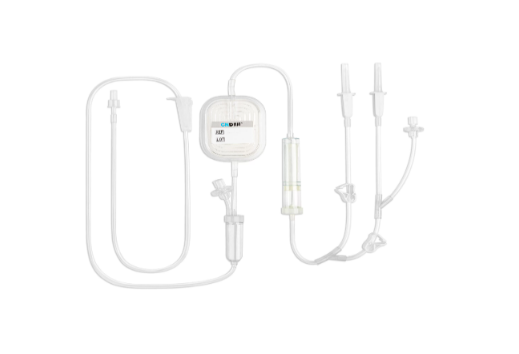Blood leukoreduction has emerged as a cornerstone of modern transfusion medicine, aimed at improving patient safety and enhancing the efficacy of blood components. By removing white blood cells (leukocytes) from red blood cells (RBCs), platelets, and whole blood, leukoreduction reduces adverse transfusion reactions, prevents alloimmunization, and lowers the risk of virus transmission. International health authorities and professional organizations have developed guidelines to standardize leukoreduction practices, particularly in both developed and resource-limited settings.
White blood cells present in transfused blood can trigger several complications. These include:
Febrile non-hemolytic transfusion reactions (FNHTR): These are the most common transfusion reactions caused by cytokines and antibodies in donor leukocytes.
Alloimmunization and platelet refractoriness: Repeated transfusions can lead to immune sensitization, complicating future transfusions.

Transmission of leukotropic viruses: Cytomegalovirus (CMV) and Epstein-Barr virus (EBV) can be transmitted via leukocytes, particularly affecting neonates and immunocompromised patients.
Immunomodulatory effects: Leukocytes can impact patient immune responses, potentially affecting clinical outcomes in vulnerable populations.
Studies indicate that leukoreduction significantly reduces the incidence of FNHTR, lowers HLA alloimmunization, prevents CMV transmission, and enhances platelet recovery. Additionally, pre-storage leukoreduction minimizes cytokine accumulation during storage, improving the overall quality and shelf-life of blood components.
Different countries and organizations have provided structured recommendations for implementing leukoreduction:
Recommends leukoreduction for red blood cells and platelets where feasible.
Highlights quality control measures to ensure consistent leukocyte removal.
Supports pre-storage leukoreduction to maximize clinical benefit.
Endorses universal leukoreduction for RBCs and platelets in the United States.
Specifies that post-filtration leukocyte counts must be below 5 × 10⁶ per unit.
Recommends documentation and monitoring of filter performance.
Requires leukoreduction in accordance with European standards, with a stricter threshold of ≤1 × 10⁶ leukocytes per unit.
Emphasizes validation of filters and continuous quality assurance.
Encourages harmonization of leukocyte count measurement and reporting.
Supports the use of leukocyte-reduced whole blood (WBLR) beyond military applications.
Recommends that WBLR units be allocated through formal processes, prioritizing clinical trials and research.
Advises against using WBLR solely to prevent product expiration.
Encourages reporting of WBLR disposition to improve transparency and optimize usage.
Recommends compliance with national blood regulations during further processing and encourages sharing clinical outcomes to enhance evidence-based practice.
Standards vary, but the common threshold is ≤5 × 10⁶ leukocytes per unit for red cells, with ≤10% red cell loss.
Selective leukoreduction strategies are often used due to resource constraints, prioritizing high-risk patients.
Buffy coat removal or selective pre-storage filtration are cost-effective approaches.
Leukoreduction can be performed using several methods:
Pre-storage filtration: Blood is filtered immediately after collection to maximize clinical benefits and reduce cytokine accumulation.
Bedside filtration: Filtration occurs immediately before transfusion, suitable for settings where pre-storage filtration is unavailable.
Washing of red cells: Removes plasma and residual leukocytes but may cause some cell loss.
Centrifugation separation: Helps isolate leukocytes but may not achieve complete removal.
Modern filters, including third- and fourth-generation leukoreduction filters, are designed to maintain high platelet and red cell recovery while achieving consistent leukocyte reduction.
Reduction in FNHTR: Universal leukoreduction can decrease the incidence and severity of febrile reactions in transfused patients.
Lower CMV transmission risk: Especially important for immunocompromised patients such as neonates and transplant recipients.
Prevention of HLA alloimmunization: Reduces platelet refractoriness in patients receiving multiple transfusions.
Improved storage quality: Red blood cells and platelets maintain integrity longer, reducing the need for frequent replacement.
Enhanced platelet recovery: Optimized filters allow better post-transfusion recovery and efficacy.
These clinical benefits are supported by multiple studies and have prompted many countries to adopt universal leukoreduction policies for blood components, even in settings with limited resources.
In developing countries or resource-limited settings, successful implementation requires careful planning:
Prioritization: High-risk patient groups such as neonates, immunocompromised individuals, and chronic transfusion recipients are prioritized for leukoreduced blood products.
Selective pre-storage filtration: Reduces leukocytes in key blood components without necessitating universal filtration.
Quality control systems: Regular monitoring of leukocyte counts, filter efficiency, and training of personnel ensures safe and effective transfusion practice.
Data sharing and reporting: Documenting outcomes helps build local evidence and informs policy decisions.
Effective leukoreduction relies on rigorous quality assurance, including:
Post-filtration leukocyte counts to verify compliance with regulatory thresholds.
Routine monitoring of filter performance and batch validation.
Personnel training to handle, store, and transfuse leukoreduced products safely.
Documentation for audits and regulatory compliance.
Integrated filter systems: Blood bags with built-in leukoreduction filters streamline workflow and minimize handling errors.
Automation: Automated devices improve consistency and reduce operator variability.
Advanced materials: Modern filters optimize leukocyte removal while preserving red cells and platelets.
Clinical research: Ongoing studies continue to refine guidelines, especially in diverse patient populations and low-resource settings.
Blood leukoreduction is a critical component of transfusion safety. Global and regional guidelines, including those from WHO, AABB, EDQM, and NAC, emphasize pre-storage filtration, quality assurance, and targeted implementation strategies. By adhering to these evidence-based recommendations, blood establishments can improve clinical outcomes, enhance patient safety, and optimize resource utilization.
DaJiMed is dedicated to providing high-quality leukoreduction filters, customizable blood bag solutions, and reliable OEM services to support blood centers, hospitals, and laboratories worldwide, ensuring safe, efficient, and compliant blood product management.
National Advisory Committee on Blood and Blood Products (NAC). Whole Blood, Leukocytes Reduced Recommendations. Canada. 2024. https://nacblood.ca/en/resource/whole-blood-leukocytes-reduced-recommendations
Sharma, R. R., Marwaha, N. Leukoreduced blood components: Advantages and strategies for its implementation in developing countries. Asian Journal of Transfusion Science. 2010;4(1):3–8. https://www.ncbi.nlm.nih.gov/pmc/articles/PMC2847337/
U.S. Food and Drug Administration (FDA). Guidance for Industry: Pre-Storage Leukocyte Reduction of Whole Blood and Blood Components Intended for Transfusion. 2014. https://www.fda.gov/files/vaccines%2C%20blood%20%26%20biologics/published/Final-Guidance-for-Industry--Pre-Storage-Leukocyte-Reduction-of-Whole-Blood-and-Blood-Components-Intended-for-Transfusion.pdf
European Directorate for the Quality of Medicines & HealthCare (EDQM). Guide to the Preparation, Use and Quality Assurance of Blood Components. 2021. https://www.edqm.eu/en/blood-transfusion
American Association of Blood Banks (AABB). Standards for Blood Banks and Transfusion Services. 32nd Edition, 2022. https://www.aabb.org/standards
World Health Organization (WHO). Guidelines on Blood Transfusion Safety. 2021. https://www.who.int/publications/i/item/9789241546696
Copyright © Guangzhou DaJi Medical Science and Technology Co., Ltd. All Rights Reserved Sitemap | Powered by 